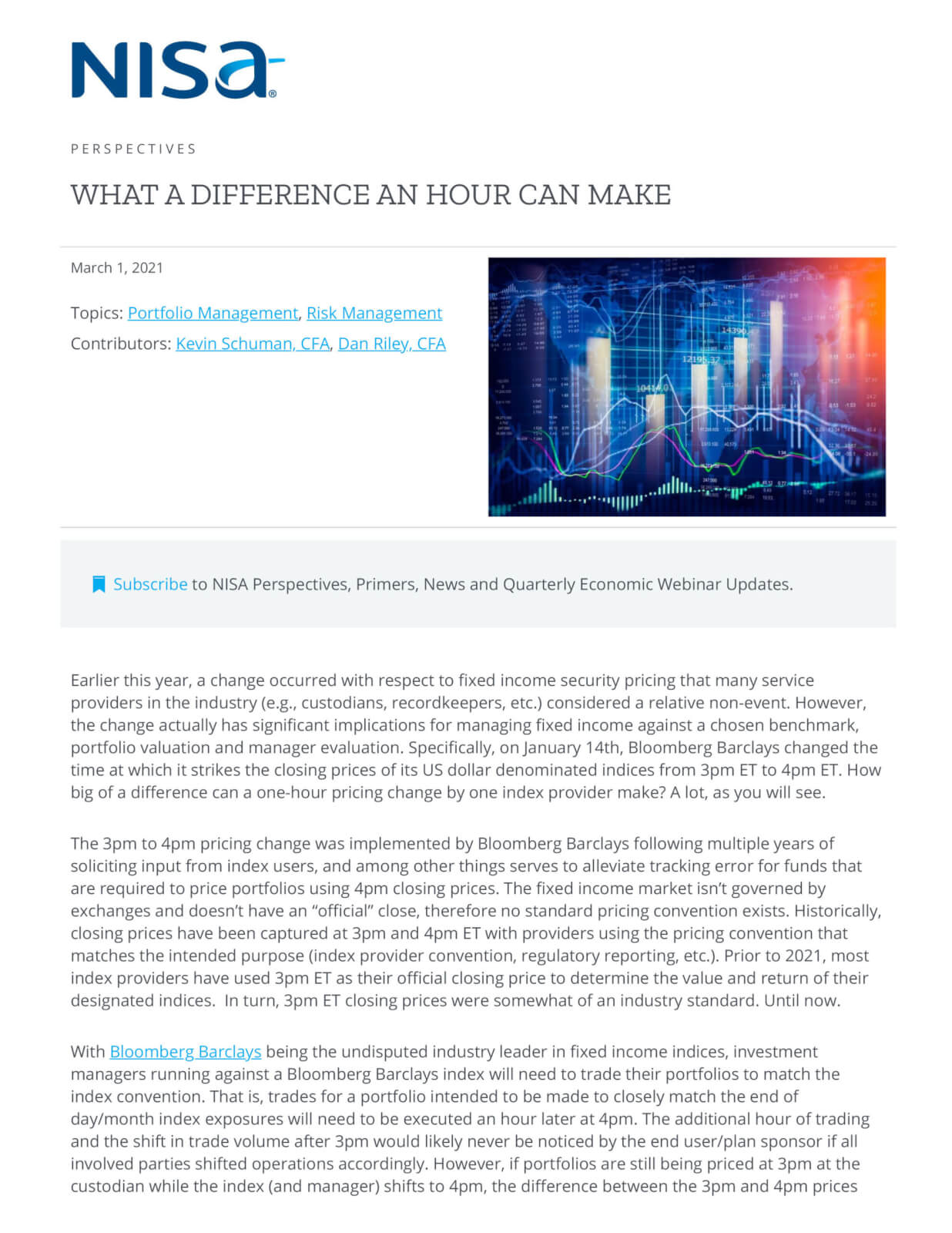Earlier this year, a change occurred with respect to fixed income security pricing that many service providers in the industry (e.g., custodians, recordkeepers, etc.) considered a relative non-event. However, the change actually has significant implications for managing fixed income against a chosen benchmark, portfolio valuation and manager evaluation. Specifically, on January 14th, Bloomberg Barclays changed the time at which it strikes the closing prices of its US dollar denominated indices from 3pm ET to 4pm ET. How big of a difference can a one-hour pricing change by one index provider make? A lot, as you will see.
The 3pm to 4pm pricing change was implemented by Bloomberg Barclays following multiple years of soliciting input from index users, and among other things serves to alleviate tracking error for funds that are required to price portfolios using 4pm closing prices. The fixed income market isn’t governed by exchanges and doesn’t have an “official” close, therefore no standard pricing convention exists. Historically, closing prices have been captured at 3pm and 4pm ET with providers using the pricing convention that matches the intended purpose (index provider convention, regulatory reporting, etc.). Prior to 2021, most index providers have used 3pm ET as their official closing price to determine the value and return of their designated indices. In turn, 3pm ET closing prices were somewhat of an industry standard. Until now.
With Bloomberg Barclays being the undisputed industry leader in fixed income indices, investment managers running against a Bloomberg Barclays index will need to trade their portfolios to match the index convention. That is, trades for a portfolio intended to be made to closely match the end of day/month index exposures will need to be executed an hour later at 4pm. The additional hour of trading and the shift in trade volume after 3pm would likely never be noticed by the end user/plan sponsor if all involved parties shifted operations accordingly. However, if portfolios are still being priced at 3pm at the custodian while the index (and manager) shifts to 4pm, the difference between the 3pm and 4pm prices could be significant. For example, for every 1 bp move in Treasury rates, we would expect a 15 duration Long Credit or Long Gov/Credit portfolio to differ by 15 bps in price. We would expect a 25 duration STRIPS portfolio to differ by 25 bps.
In anticipation of this disconnect, in December we contacted our clients and our clients’ custodians to determine if the custodians could accommodate a change in the pricing methodology from 3pm to 4pm. The responses were mixed as a few offered 4pm, others agreed to move but needed time to implement the changes, but many custodians determined no change was necessary. In the view of the custodians unwilling to change, the pricing feed services have been long established with a 3pm feed and there was no compelling reason to change. In their eyes, pricing changes between 3pm and 4pm were minor and any impact of comparing 3pm valued portfolios to 4pm valued benchmarks would be negligible.
Our view is that custodians significantly under-estimated the volatility in pricing that could result from one-hour difference in trading. To their credit, some of the custodians performed a historical analysis of bond prices between 3pm and 4pm to help inform their decision. However, we feel there are likely multiple flaws with this type of analysis:
- The analysis is done on a historical period that represents “after-hours” trading and was typically not heavily traded. The current 3pm to 4pm window represents the final hour of trading, the heaviest trading of the day, when many contributions and withdrawals and being invested.
- Month-ends are different than normal days. Whether due to index reconstitution rules that necessitate trading, or the monthly rebalancing process that many market participants engage in, trading volume in the hour prior to the month-end close is typically higher than any other time of the month.
- It’s not clear if the custodians were evaluating all bonds in this analysis, or specifically long duration bonds. The longer the duration, the more this issue matters. For example, a 3 bps move in Treasury rates between 3 and 4pm will only affect a broad market Aggregate portfolio with a 6-year duration by 18 bps, however it will impact a 25-year duration STRIPS portfolio by 75 bps.
At this point, you may be asking why is NISA sending this e-mail. Didn’t NISA send a similar warning in December regarding the potential for this issue to affect reporting and performance? We are sending this now, because of what happened on Friday, February 26th between 3pm and 4 pm. On Friday we saw yields on 30-year Treasury bonds fall from 2.185% at 3pm to 2.112% at 4pm. A drop of over 7 bps in the last hour of trading!
Some quick math suggests we may see pricing differences on a ~15-year duration Long Credit type account of ~105 bps (15 x 7 = 105 bps) and pricing differences on a ~25-year duration STRIPS account of ~175 bps (25 x 7 = 175 bps). Reported performance on those accounts for February will be similarly misleading, however it will be modestly offset by the reality that the January pricing was also off as Treasury rates declined by 1.5 bps in the final hour of trading. The negative performance relative to the index will wash out/revert in March if the 3pm and 4pm prices are the same, but in the here and now, the differences are extraordinary.
We likely don’t need to tell our clients the importance of good accounting as the reasons are plentiful. Certainly, these types of differences make manager performance evaluation difficult. But, we also have a significant number of clients that use these values to monitor funded status and determine asset allocation, required contributions, etc. When you start to see differences of the magnitude above, the issue simply can’t be ignored.
So what can you do if your custodian is still using 3pm pricing? Strike while the iron is hot and ask your custodian about their February month-end valuations. Ask them to reconsider previous decisions in light of two month-ends resulting in significantly different valuations. And if push comes to shove, ask them if it would ever be appropriate to value the equities in the portfolio an hour earlier than the closing bell. Effectively, that is what is happening in your fixed income portfolios by using 3pm instead of 4pm prices.




